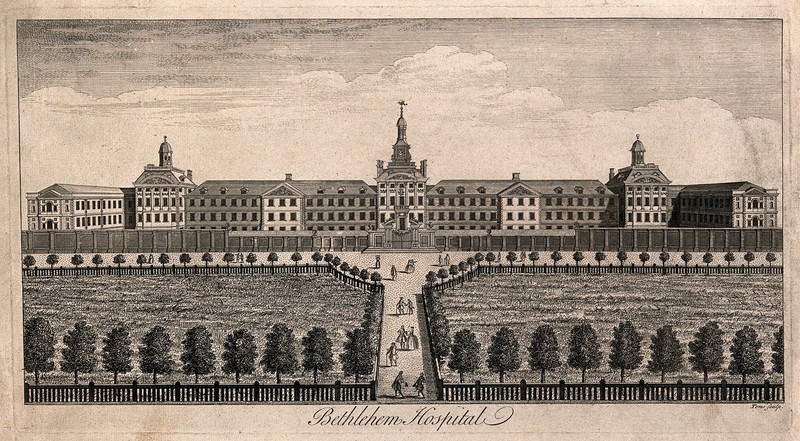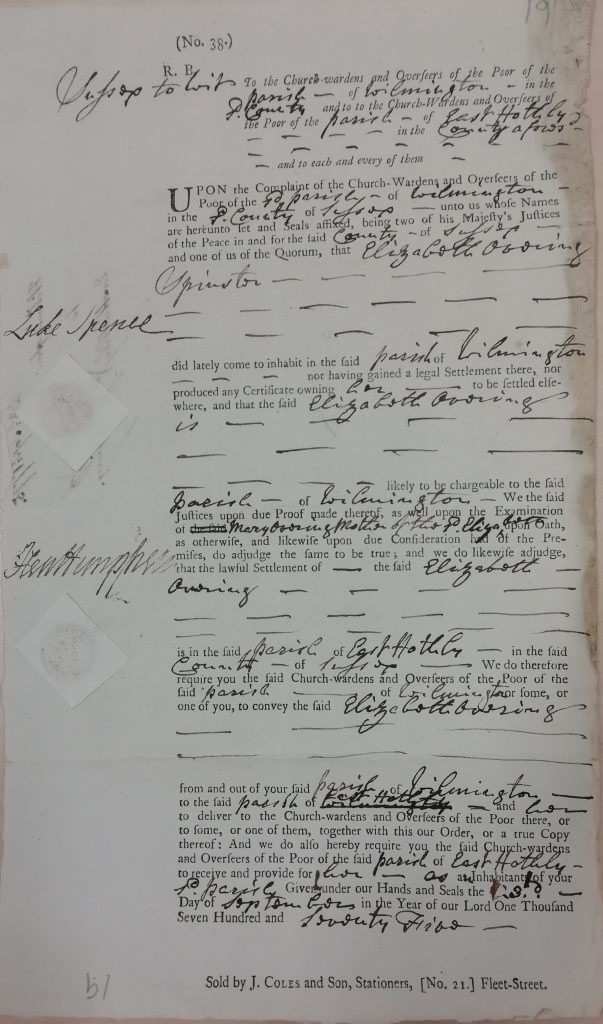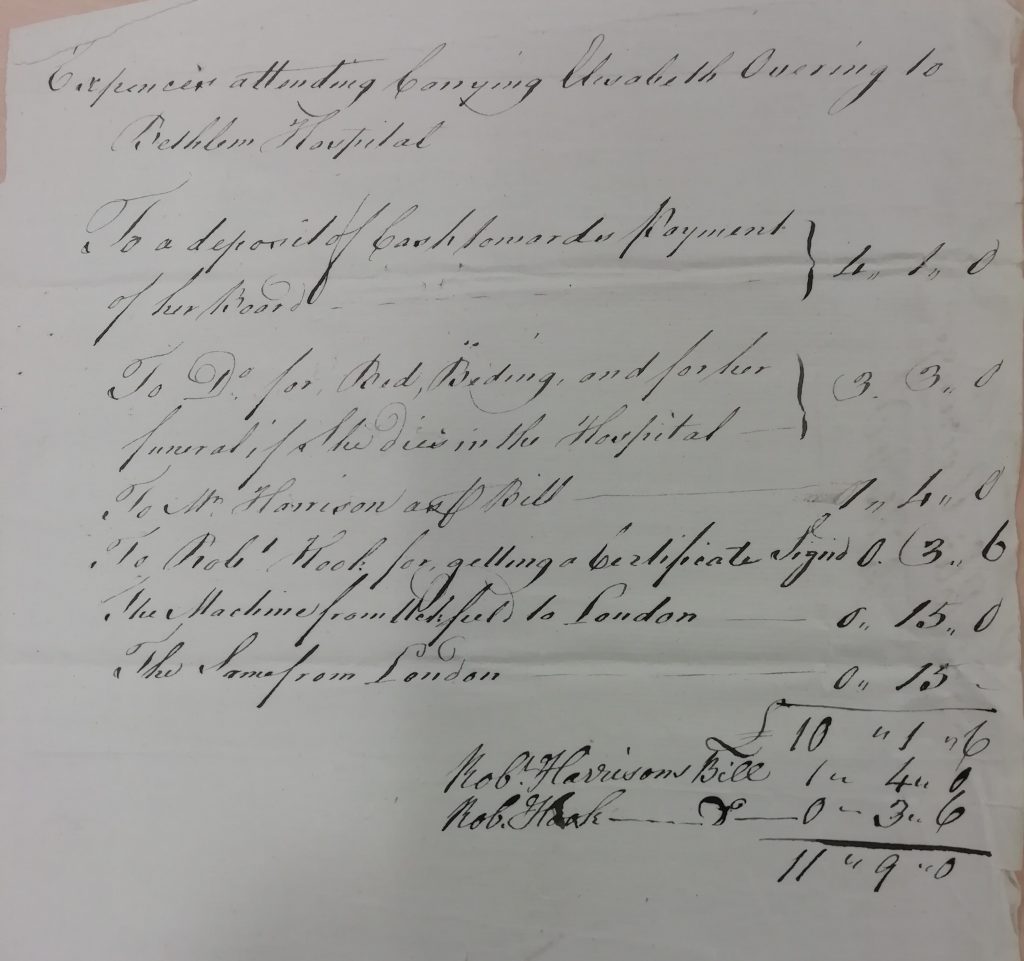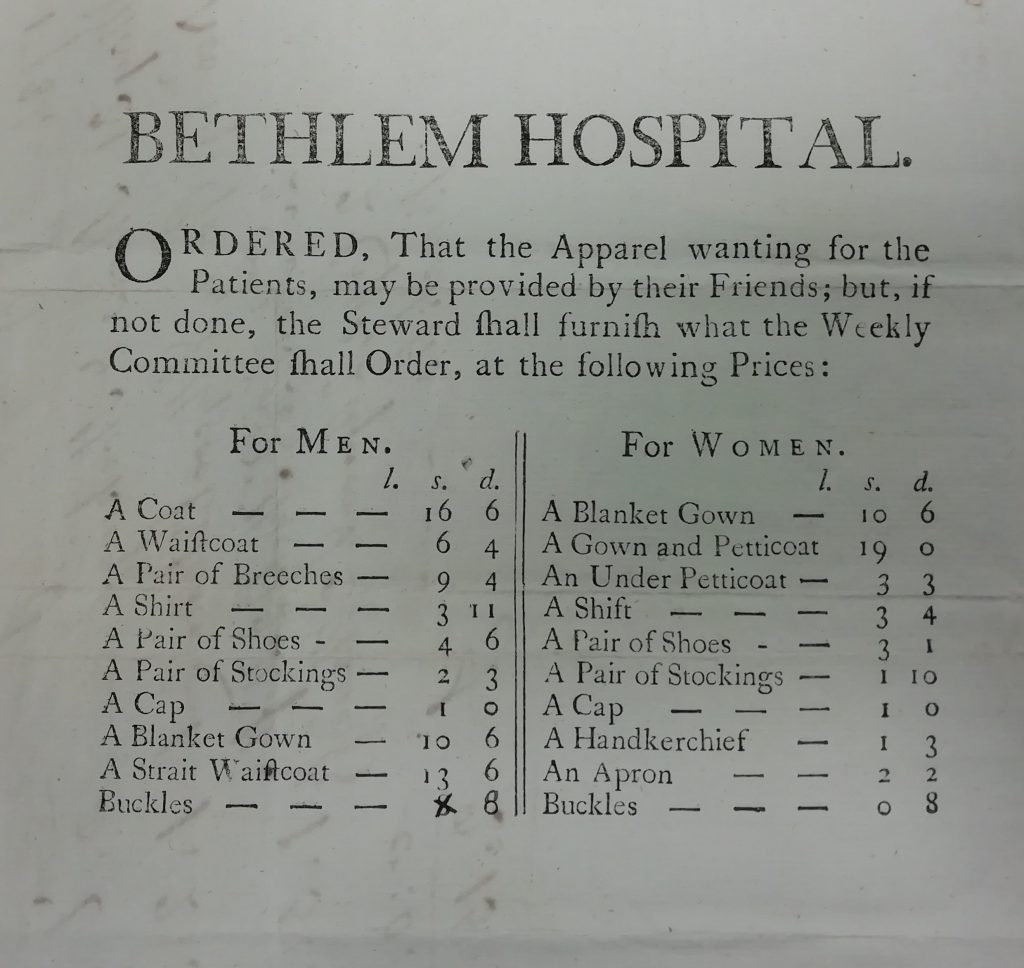Elizabeth Overing was probably the Elizabeth, daughter of John and Mary Overing, who was baptised in Wilmington on 21 September 1746. Her parents had married in Wilmington in 1740 and she had three siblings also christened there: Thomas (1741), Mary (1743) and John (1745). Her father died in 1773, leaving a will which reveals that he was a bricklayer and glazier in Wilmington who held several copyhold properties of the manor of Wilmington. The will acknowledged all four children and left £3 a year for Elizabeth but only after her mother’s death.

Things seem to have gone wrong fairly soon afterwards as she was admitted to Bethlem Hospital, colloquially known as Bedlam, on 17 May 1774 by Wilmington parish. Originally founded as the Priory of the Church of St Mary of Bethlehem near Bishopsgate in 1247, Bethlem was being referred to as a hospital to house the insane by 1403. Patients came from across the country and were often poor. In the 17th century it moved to new premises in Moorfields, and it was to this incarnation of the hospital that Elizabeth Overing was admitted. It was usual for new patients to spend about a year in the hospital’s general ward after which, if they were not cured, they were assessed as to whether they were ‘fit’ to receive the hospital’s charity in the incurable ward. Elizabeth Overing was discharged ‘not fit’ on 19 May 1775.

She returned to Wilmington and by 3 September 1775 she was the subject of a removal order from Wilmington to East Hoathly. The order records that Mary Overing, Elizabeth’s mother, was examined as to her daughter’s settlement. Since Elizabeth would by now have been 29, this suggests that she may not have been considered able to answer for herself. East Hoathly appealed the removal order at Quarter Sessions in October 1775 but the order was confirmed. There is no explanation as to how she had gained a settlement in East Hoathly but gain it she did. From this time, Elizabeth appears regularly in the East Hoathly overseers’ accounts, where payments record her maintenance by John Tampkin and John Watford at 3s 6d a week, later increasing to 5s.
By November 1781, Elizabeth was beginning to prompt additional activity: John Burgess, innkeeper, incurred expenses in travelling to Uckfield on business concerning her, probably with the local magistrates. By January 1782 the process had begun to admit Elizabeth Overing to Bethlem Hospital once more and the timeline can be traced from the East Hoathly accounts and Bethlem archives.
John Watford’s maintenance payments for her ended on 12 January 1782, which was the original date for her planned admission to Bethlem. Instead, she was conveyed from Uckfield to Hoxton, where she was maintained by a Mr Robert Harrison from 12 to 26 January at 10s 6d a week. A London Fire Insurance Policy register places a Robert Harrison, gentleman, in a business property near the Jewish burial ground in Hoxton in 1781. The burial ground was next to Hoxton House, one of a number of mad houses for private mental health patients situated there at the time. Hoxton was also known for its houses to which London parishes could send their poor if they did not run workhouses, a system known as farming. It may be, therefore, that Elizabeth was accommodated in one or other of these institutions until Bethlem was able to accept her.
Meanwhile, on 17 January, Robert Hook, shoemaker, obtained a settlement certificate for Elizabeth Overing from the Uckfield magistrates, acknowledging East Hoathly as her place of settlement and this was lodged with Bethlem Hospital when she was finally transferred there from Hoxton and admitted as an incurable on 26 January 1782.

The parish appears to have appointed representatives to act on its behalf since on the same day of her admission, a bond was entered into between the Bethlem authorities and two residents of the City, Robert Morphett, hosier, and Frederick Smith, gentleman, stating that they had requested Elizabeth Overing’s admission to the hospital as an incurable and obliging them to pay 2s 6d per week for her board and to cover clothing bedding and funeral expenses. That these expenses were passed on is clear from the East Hoathly vouchers, which show that the parish paid deposits of £4 1s 0d towards her board and £3 3s 0d towards her bed, bedding and funeral if she were to die at the hospital. In 1789 the parish seems to have changed its local representatives as a second bond was taken out with the Bethlem authorities, this time by John and Thomas Russell, carpenters. By now the weekly fee had gone up to 5s.

Invoices for expenses were regularly passed on to East Hoathly. For example, in the year ending 28 December 1784, the parish was invoiced £6 10s 0d for board and £2 15s 0d for clothing, which included shoes and stockings, a gown, petticoat and undercoat, shifts, caps, aprons, handkerchiefs and buckles, provided at Bethlem’s standard charge. In the year ending 31 December 1793 the costs had risen to £15 2s 2d for board with £2 10s 11d for clothing, a rise of almost 100% in nine years though the sums involved were not, in terms of board, any higher than the parish had been paying Tampkin and Watford.
Nothing else survives to indicate how Elizabeth was treated at Bethlem. However, we know that patients were held in cells in the wings of the hospital off long galleries. Until 1770, when the practice was ended, these galleries were open to visitors and the inmates were something of a tourist attraction. At least Elizabeth did not have to suffer that indignity. However, witness statements given to the Committee on Madhouses in England in 1815 reveal that many patients were kept in bed, especially women; that some patients were found naked and covered only by straw on the floor of their cells; that there was inadequate medical supervision; and that some were kept in chains. The Matron reports that she had 66 women in her care, four or five of whom were restrained. She continues:
One of the female patients has been confined a long time, chained by the leg, as much as five or six years, I have been told; and we have another constantly chained by the hands, that came in about two months since, two of the other blanket patients are only chained at times. I have them loose, to walk about occasionally.
In August 1815 Bethlem’s patients were transferred to new premises in Southwark (on the site of what is now the Imperial War Museum) because the old building was considered beyond repair. Elizabeth did not live to see it: she died on 2 June. Her burial place has not so far been identified. It was not generally the responsibility of the hospital to bury its deceased patients and it did not have its own dedicated burial ground. Her burial is not recorded at either Wilmington or East Hoathly.